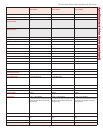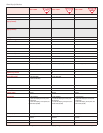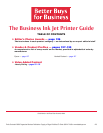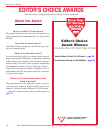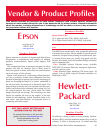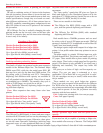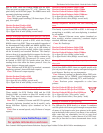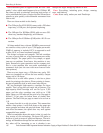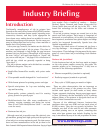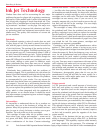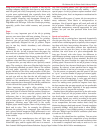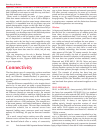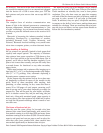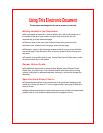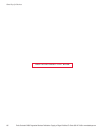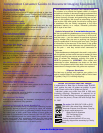
132
Entire Contents © 2006 Prog
ressiv
e Business Pub
lications
.
Copying of Pages Prohibited.To Order: 800 247 2185 or www.betterbuys.com
Ink Jet Technology
Vendors have done well in overcoming the two major
problems that used to plague ink jet printing: consistency
and quality. Older models used to suffer from uneven ink
flow, along with clogging of heads from dried ink. They
required a lot of maintenance to keep them from produc-
ing occasional “accidents” on the page. But major ven-
dors have invested in improved ink chemistry and deliv-
ery technology and have engineered more nozzles into a
smaller area. The quality and resolution of current ink
jets are excellent.
Printheads
The printhead contains a series of nozzles that are used
to spray drops of ink. The head is moved from side to
side, and the paper is slowly moved forward as each line
of ink is laid down. The spacing of the nozzles is the key
to the resolution of the printer. At 600dpi resolution, noz-
zles are spaced every 42.5 micrometers (about 1/600 of
an inch),
hence 600 nozzles per inch. Typical printheads
are fr
om one-third to one-half inc
h in width,
though the
newer HP Officejet Pro models are coming out with very
wide heads
, adding to print speed. In addition, some
ne
wer printheads have more than one row of nozzles.
Minia
turiza
tion is leading to higher resolutions and high-
er speeds.
Printheads have traditionally had the problem of
becoming clogged. This is particularly the case when the
printer is not used frequently, leading to ink drying on the
nozzles
. There are several ways to address this problem,
as recommended by your vendor. You can access the
heads and clean them (there are commercial solvents for
this purpose). You can use a self-cleaning function that
more and more ink jets offer (check your printer manual).
Or you can replace the printhead or (more likely) the car-
tridg
e
, which is often integrated with the printhead in
of
fice printers, as we discuss below. It should be noted
that improvements in engineering have reduced clogging
problems considerably.
Ink car
tridg
es
It’s important to understand that as far as vendors are
concerned, they are in the business of selling ink, not
printers. Many ink jet printers are sold at break-even mar-
gins (or even at a loss), the better to induce you to get a
machine. The real profits are in the cartridges.
Ink car
tridg
es in some older ink jet printers came in
three colors (cyan, yellow, and magenta — some even in
r
ed,
g
r
een,
and b
lue).
Blac
k ar
eas like type were made
from a combination of the three. Current technology
involves four colors — black, cyan, yellow, and magenta
— just like color laser printers. Note that, depending on
the manufacturer and the model, the three color inks may
be combined in a single cartridge or sold as independent
cartridges, one for each color. The idea is that individual
cartridges can save money, since if you run out of, for
example, magenta ink, you don’t need to toss out the yel-
low and cyan ink left in the cartridge. You can simply
replace the magenta cartridge.
The cartridges of many office ink jet printers include
the printhead itself. Since the printhead can wear out or
get dirty, replacing it every time you replace the cartridge
has the benefit of making the printer easier to maintain.
On the other hand, it does seem wasteful to replace a part
that potentially could last thousands of pages every time
you reload the ink. On some printers, cartridges and
printheads are separate consumables.
Cartridges can be refilled, but manufacturers advise
against it. That’s partly a matter of trying to get you to
buy new high-priced cartridges from them (after all, that’s
where the money is). But it also brings up a very real con-
cern. As ink formulations have been tailored more and
more expressly for each vendor’s printing technology,
replacement inks will not work as well as the manufactur-
er’
s own. You ma
y want to experiment with some of the
refill solutions, but make sure you test any such scheme
thoroughly. Furthermore, because of the integration of
ink car
tridge and printhead on many models
, you may
find that the printhead wears out after only a few refills.
Furthermore, photographic prints that do not use the
man
ufactur
er’
s own ink will fade far more rapidly. In a
home situation, refills might make sense. In a business
situation, it may not be advisable.
Printer controls
A CPU (processor) and a small amount of circuitry are
built into each printer to control both the mechanical
aspects of operation (such as the transport system that
moves the printhead and the paper) and the decoding of
inf
or
mation sent to the printer from the computer. Most
inexpensive ink jet CPUs are not very smart about han-
dling tha
t code:
it ar
ri
v
es alr
ead
y encoded as a series of
on/off instructions, pre-translated by the computer send-
ing the job (using a technology called GDI in Windows).
T
his a
pproach requires only a relatively basic processor
and a small amount of memory. In fact, many vendors
don’t even state the processor speed or memory capacity
on their ink jet models, quite the opposite of the laser
printer market.
But many of the business ink jets we cover offer the
a
bility to interpret jobs sent in either PCL or PostScript
print languages. This capability requires added memory
and mor
e m
usc
le in the pr
ocessor
.
T
he ad
vantage of
Better Buys for Business



